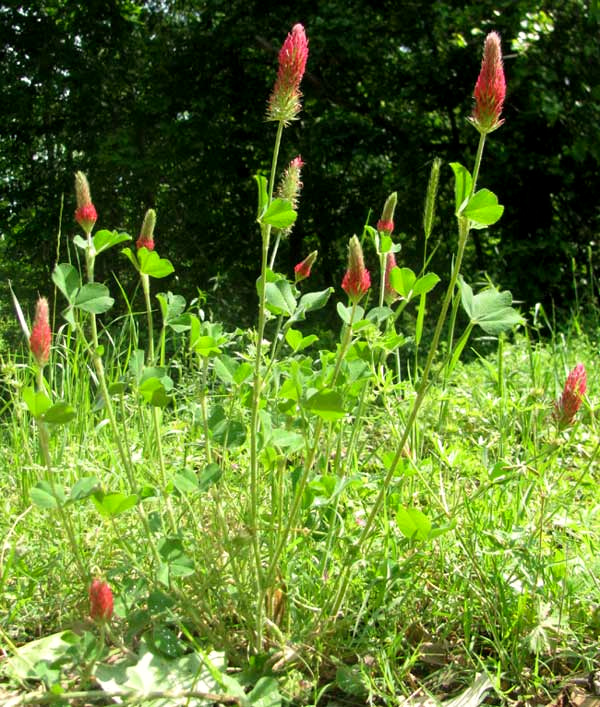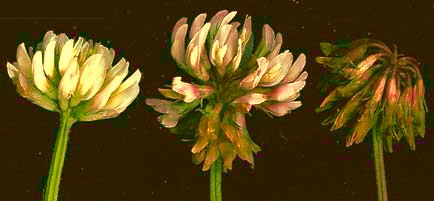 In the picture at the right, the sphirical, white item at the top of the slender stem is not a clover flower. It's a head of flowers, also known as an inflorescence. Each one of the slender, white things in the head is a flower. The inset at the top right of the picture shows a much magnified image of a single flower in the head, with its main corolla parts identified.
In the picture at the right, the sphirical, white item at the top of the slender stem is not a clover flower. It's a head of flowers, also known as an inflorescence. Each one of the slender, white things in the head is a flower. The inset at the top right of the picture shows a much magnified image of a single flower in the head, with its main corolla parts identified.
When we refer to "clovers" we're speaking of members of the genus Trifolium in the Bean Family, the Fabaceae. Around 300 species of Trifolium exist. The one above is White Clover, Trifolium repens, a very common citizen of weedy lawns. Besides the fact that its flowers are white, one feature distinguishing White Clover from many other clover species is that its stem creeps along the ground issuing roots from nodes, or joints, along the stem. In the picture you can see white roots dangling from the horizontal stem.

Most other clover species are upright or leaning, but not really creeping and rooting along the stem. At the left you see another "variation on the clover theme," displayed by western North America's Woollyhead Clover, Trifolium eriocephalum. Its flowers droop in the head instead for forming a sphere, plus the flowers' calyxes and sepals are long-hairy. Both White and Woollyhead Clovers produce leaves with three leaflets, but some clover species have 1 to several leaflets.

All clovers, however, produce heads or dense spikes of small flowers that bring forth small, legume-type fruits containing one to a few seeds. The species at the right, Crimson Clover, Trifolium incarnatum -- native to Europe but much planted and escaped in North America and many other countries -- displays the typical three leaflets, but its flowering heads are tall and slender, and red.
Below, White Clover flowering heads are doing something very interesting that you should look for when you're wildflower-looking, whichever clover species you happen to have at hand.

At the far left in the picture is a young head with its flowers just opening up. In the middle, a head has top flowers just opening up, flowers at its middle beginning to wither, and at the bottom the flowers are brown and faded. Here's what's happening:
Young flowers are bright and are held upward, enabling visiting pollinators such as small bees to see them better, land on them and take nectar. Then once the flowers have been pollinated there's no reason to remain bright and upright, so the flowers fade and droop. The next pollinator won't waste time trying to pollinate the brown, droopy, already-pollinated flowers, but will concentrate on the younger flowers at the top needing pollination.
At the right in the picture, all the flowers have been pollinated and no decent pollinator would be attracted to them. Still, sheltered by the faded corollas, the ovaries slowly are enlarging and maturing toward becoming one- or two-seeded legumes. Legumes are simple, dry fruits, as explained on our Simple Dry Fruit page.